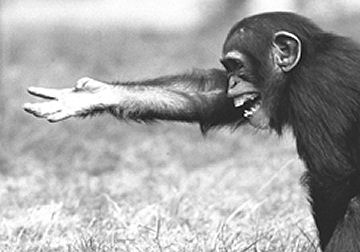Talking with Hands
Studies of chimpanzees suggest that our ancestors may have "talked" to each other using hand gestures before they learned to speak.
Share this:
- Share via email (Opens in new window) Email
- Click to share on Facebook (Opens in new window) Facebook
- Click to share on X (Opens in new window) X
- Click to share on Pinterest (Opens in new window) Pinterest
- Click to share on Reddit (Opens in new window) Reddit
- Share to Google Classroom (Opens in new window) Google Classroom
- Click to print (Opens in new window) Print
By Emily Sohn
Thumbs up. A friendly wave. A threatening fist. All these hand gestures are part of the body language that we use to communicate every day.
Chimpanzees and bonobos, which are sometimes called pygmy chimpanzees, use their hands to convey messages too. And new research shows that these primates are better at communicating with their hands than they are with smiles, frowns, and other facial expressions. Because chimpanzees and bonobos are our closest primate relatives, the discovery may help explain how language developed in people.
 |
|
Depending on the circumstances, this hand gesture can mean either “I would like some of that food” or “Please help me.” |
| Frans de Waal/Yerkes National Primate Research Center |
Our ability to communicate with words separates us from other primates, and researchers have long wondered where this ability came from. According to one theory, our apelike ancestors first communicated through hand gestures.
Over time, certain parts of the apes’ brains adapted to this kind of communication. Eventually, those brain regions could have switched to controlling speech. In support of this theory, research has shown that apes today use the same region of the brain to think about hand gestures as people use to understand words.
To further investigate the link between hand gestures and speech, scientists from the Yerkes National Primate Research Center in Atlanta observed 47 primates in captivity. Thirty-four were chimpanzees, and 13 were bonobos.
The researchers recorded every hand gesture, facial expression, and voiced noise that one ape made to another. The scientists also recorded whether the animals were playing, grooming, eating, or performing other behaviors at the same time.
Results showed that each facial expression and cry almost always corresponded with just one context, for example, when the animal was afraid.
Each hand gesture, on the other hand, could take on more than one meaning, depending on the situation. For example, when the animal was hungry, reaching out with the palm of the hand facing up meant, “More food, please.” The same gesture made while a fight was going on, however, meant, “Please help me.”
The ability to use a single gesture to mean different things in different contexts suggests that the apes can use hand gestures in a flexible way. Like our words, the animals’ gestures can be used in a variety of emotional and social settings.
Fossils can tell us a lot about apes’ physical characteristics, but they reveal little about the animals’ communication behaviors. So, evidence from our nearest relatives is the best way to study the development of language in humans. We share a common ancestor with chimps and bonobos that lived until about 6 million years ago. Those two ape groups split from each other about 2.5 million years ago.
“I think this is the best kind of evidence that you’ll find” for how language evolved, says Susan Goldin-Meadow. She studies human gesture and language at the University of Chicago.
In every culture, people still use hand gestures while they talk. The habit is a relic, perhaps, of our expressive history.—Emily Sohn
Going Deeper:
Barry, Patrick L. 2007. Talk to the hand: Language might have evolved from gestures. Science News 171(May 5):275-276. Available at http://www.sciencenews.org/articles/20070505/fob2.asp .
Sohn, Emily. 2006. If only bones could speak. Science News for Kids (May 10). Available at http://www.sciencenewsforkids.org/articles/20060510/Note2.asp .







